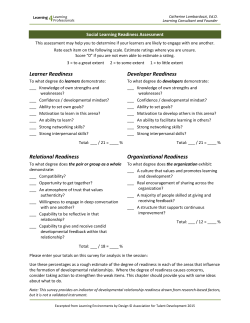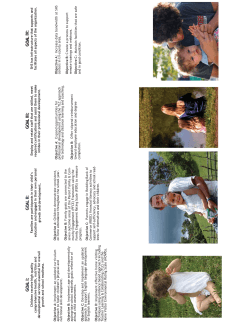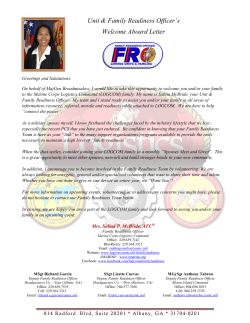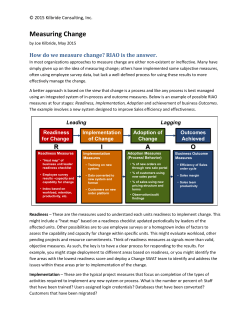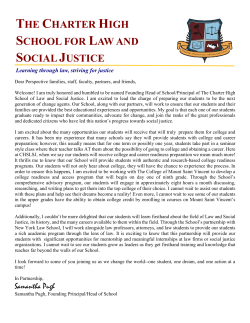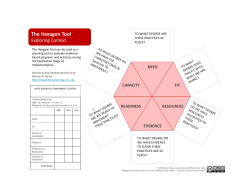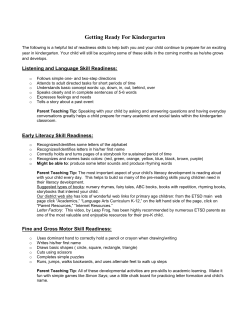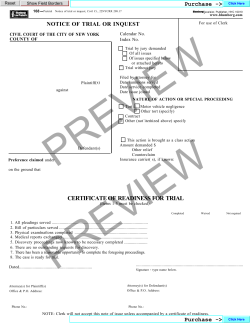
School Readiness Goals for Preschool Children in Head Start Programs:
School Readiness Goals for Preschool Children in Head Start Programs: Examples from the National Center on Quality Teaching and Learning The Improving Head Start for School Readiness Act of 2007 makes it a top priority for programs to contribute to the school readiness of all of the children they serve. In very broad terms, the Office of Head Start’s definition of school readiness is that “children are ready for school, families are ready to support their children’s learning, and schools are ready for children” (2011 Leadership Institute Planner, p. 37). As programs work to contribute to children’s learning and development, Head Start leaders must clearly identify the goals and skills children demonstrate when they are “school ready.” A clear articulation of these goals and skills allows Head Start staff to choose and implement the most effective curriculum, assessments, and teacher-child interactions. In this document, the National Center on Quality Teaching and Learning (NCQTL) offers examples of school readiness goals for preschool children that programs may consider as they establish their own. NCQTL defines school readiness in terms of the knowledge and skills children display in five major areas of development that are aligned with the Head Start Child Development and Early Learning Framework (HSCDELF): Social and Emotional Development; Language Development and Literacy; Approaches to Learning; Cognition and General Knowledge; and Physical Well-Being and Motor Development (PI-11-04). The Office of Head Start, in an attachment to its Program Instruction on School Readiness, outlines four steps for programs to ensure school readiness for the children they serve. The first step is to establish school readiness goals that are aligned with the HSCDELF, with state early learning standards or guidelines as appropriate, and with the requirements and expectations of the schools the children will be attending. NCQTL designed the goal examples presented below to assist in this step. 1 Goal Statements NCQTL offers the following examples of goal statements for children’s learning and development in Head Start. These examples have two key features: • They are broad statements that articulate high expectations for the progress children served in Head Start will attain to be ready to succeed in kindergarten. • They focus on how children’s skills and knowledge will progress and how this progress will be measured. For each of the five essential domains below, NCQTL provides examples of goals for children’s development as well as specific areas of knowledge and skill associated with each goal. Grantees must articulate the multi-step process they followed to adopt their school readiness goals and how that process: • Reflects the ages of the children, birth to five, participating in the program. • Aligns with HSCDELF and guidelines of state and local education agencies. • Includes the five essential HSCDELF domains. • Encompasses the range of all children served (e.g., are applicable for children who are dual language learners and children with disabilities). • Is conducted in active and ongoing consultation with parents participating in the program. 2 Following are examples of preschool school readiness goals: Social and Emotional Goal Examples 1. Children will engage in and maintain positive adult-child relationships and interactions. 2. Children will engage in and maintain positive peer relationships and interactions. 3. Children will display levels of attention, emotional regulation, and behavior in the classroom that are appropriate to the situation and the supports available. 4. Children will learn and internalize (follow) classroom rules, routines, and directions. 5. All children will develop and display a sense of self, confidence in their abilities, and a strong identity that is rooted in their family and culture. Language and Literacy Goal Examples 1. Children will build, use, and comprehend increasingly complex and varied vocabulary. 2. Children will use and comprehend oral language for conversation and communication. 3. Children can identify and discriminate the sounds within words, as separate from the word itself. 4. Children will use and understand print as a system of visible marks that represent the sounds within words and words themselves. 5. Children will engage with literature in developmentally appropriate ways. 6. Children who are dual language learners (DLLs) will demonstrate increased competency in their home language while developing proficiency in English. Approaches to Learning Goal Examples 1. Children will show an interest in varied topics and activities, an eagerness to learn, creativity, and independence in their interactions with activities and materials. 2. Children will demonstrate persistence when working with materials, activities, and information. 3. Children will learn and use words and concepts that parallel the information available in activities and materials. 3 Cognition and General Knowledge Goal Examples 1. Children will use math regularly and in everyday routines to count, compare, relate, identify patterns, and problem solve. 2. Children will use observation and manipulation, ask questions, make predictions, and develop hypotheses to gain a better understanding of information and activities in their surroundings. 3. Children will use their skills in remembering information and in being aware of their own thinking. Physical Well-Being and Motor Development Goal Examples 1. Children will demonstrate control of large muscles for movement, navigation, and balance. 2. Children will demonstrate control of small muscles for such purposes as using utensils, self-care, building, writing, and manipulation. 3. Children will identify and practice healthy and safe habits. 4 Following are the goal examples with additional descriptions. Social and Emotional Goal Examples (5) 1. Children will engage in positive adult-child relationships and interactions. This includes orally and gesturally communicating needs, wants and information; seeking help from an adult and using adult assistance to solve challenges and explore the environment; cooperating with adult requests; and demonstrating signs of valuing the adult’s attention (e.g., sharing pride in accomplishments, mutual positive emotions, sharing information and affection). 1 1 See the Parent, Family and Community Engagement Framework for similar goals 2. Children will engage in positive peer relationships and interactions. This includes cooperating in the shared use of space, materials, activities, and adult attention; verbal and gestural communication of needs, wants, and information; emotionally positive interactions and exchanges; and pro-social forms of conflict management (e.g., seeking adult help, moving away from conflict, lack of aggression). 3. Children will display levels of attention, emotion, and behavior in the classroom that are appropriate to the situation and the supports available. This includes persisting with challenging tasks (e.g., puzzles, listening to stories) when the activity is appropriate and an adult is present and provides support; showing a range of positive and negative emotions under circumstances in which those reactions are appropriate; and showing physical activity and behavior that fit with the activity and demonstrate awareness of limits and others’ experiences (e.g., movement that is not intrusive). Children’s levels and range of expression of attention, emotion, and behavior in the classroom also show connections and responsiveness to adults’ feedback and support. 4. Children will learn and internalize (follow) classroom rules, routines, and directions. This includes responding to adult requests, directives, and feedback; use of materials and space consistent with rules and directions; and cooperation with group transitions and movement (e.g., changing activities, lining up). 5. All children will develop and display a sense of self, confidence in their abilities, and a strong identity that is rooted in their family and culture. This includes children’s abilities to understand and describe themselves as an individual and within the context of their family and cultural environment. Children are able to express their ideas and feelings about themselves in increasingly complex ways. Children express confidence in their abilities while participating in activities or when talking about future events. Children may express their cultural knowledge and identify in a variety of ways. 5 Language and Literacy Goal Examples (6) 1. Children will use and comprehend increasingly complex and varied vocabulary. This includes understanding and using a wide variety of labels to describe people, objects, attributes, and actions; understanding and producing words that describe the relationship among objects or events (e.g., positional, comparison, and time concept words); steadily developing a large store of words that are understood and words that are produced; and developing a deeper knowledge of words (e.g., awareness of multiple meanings, using words with increasing specificity). Children who are DLLs may demonstrate these increasing abilities in their home language or in English. 2. Children will use and comprehend oral language for conversation and communication. This includes engaging in multiple turn conversations; describing and understanding connections among story and event parts (i.e., sequence, cause-effect relations, etc.); communicating needs, wants, and desires using words, phrases, and sentences; following increasingly complex and multi-step directions; and using increasingly complex and longer sentences. Children who are DLLs may demonstrate these increasing abilities in their home language or in English. 3. Children can identify and discriminate the sounds within words as separate from the word itself. This includes identifying and manipulating (blend, segment, delete) smaller units of sound within a word (rhyme, syllable, individual sound). Children who are DLLs may demonstrate these increasing abilities in their home language or in English. 4. Children will use and understand print as a meaningful and organized symbolic system of communication. This includes knowing and identifying letter names and sounds (connecting oral with printed versions); identifying book parts and print concepts; and writing letters and their own names as well as other emergent writing efforts. Children who are DLLs may demonstrate these increasing abilities in their home language or in English. 5. Children will engage with literature in developmentally appropriate ways. This includes indicating an interest in and selecting books to look through and listen to. It also includes listening to stories and developing active strategies for understanding the content (e.g., predicting, summarizing, and questioning). Children who are DLLs may demonstrate these increasing abilities in their home language or in English. 6. Children who are dual language learners (DLLs) will demonstrate increased competency in their home language while developing proficiency in English. This includes the ability to understand and use increasingly more complex language in both their home language and English. As their vocabulary becomes more varied and complex, they are able to express a broader content of knowledge. 6 Approaches to Learning Goal Examples (3) 1. Children will show an interest in varied topics and activities, an eagerness to learn, creativity, and independence in their interactions with activities and materials. This includes the child seeking a range of activities, information, or materials that foster learning and skills (e.g., puzzles, centers, building materials, activities with science and social studies information) and engaging with those activities and materials to provide information and skill development opportunities; manipulating activities, materials, and information in conventional ways and in new and unusual ways (e.g., making novel uses of a set of building blocks, using dolls in new roles); and working with activities, materials, and information on their own as well as in a group. Children will demonstrate an interest in learning about the world and in working in groups. 2. Children will demonstrate persistence and sustained attention when working with materials, activities, and information. This includes demonstrating focused effort and engagement at the start of an activity and throughout periods in which the activity, materials, or information are challenging; asking for help when appropriate and using the help to continue engagement in the activity, materials, or information; and demonstrating signs of pride and accomplishment during and after engaging with activities, materials, or information (e.g., children enthusiastically share with teachers something they have done or shows signs of how hard they have worked on something). 3. Children will learn and use words and concepts that parallel the information available in activities and materials. This includes talking alongside their behavior using words that describe the materials or actions or their thinking; speaking about the activity or materials with peers or adults in the vicinity; and using words to convey plans and goals for their play or actions. Cognition and General Knowledge Goal Examples (3) 1. Children will use math regularly and in everyday routines to count, compare, relate, identify patterns, and problem solve. This includes counting accurately up to 10 objects; showing 1:1 correspondence in counting; comparing objects and quantities in relation to size, weight, volume, and temperature and using relevant terms for relations (e.g., bigger, heavier, hotter, etc.); identifying cause and effect in actions; identifying patterns and repeats in various forms (e.g., using blocks or naturally occurring patterns to describe shape, color, size, etc., regularities); and using number or quantity to solve problems (e.g.: If we take one away from this group of four beads, how many are left? or Do we need more or less water in this cup to make these two the same?). 7 2. Children will use observation and manipulation, asking questions, making predictions, and developing hypotheses to gain a better understanding of information and activities in their surroundings. This includes describing what the child sees and hears; asking questions of adults about activities and information of which the child is aware; guessing about what will happen next or why something may have happened; guessing or speculating about what might happen if circumstances or conditions were different; and identifying possibilities for multiple solutions to questions, tasks, and problems. 3. Children will increase their skills in remembering information and in being aware of their own thinking. This includes remembering both short and longer-term information (e.g.: What happened this morning? What happened a month ago?) as well as memory skills for increasing recall of letters or numbers or facts; and children’s awareness of their use of recall or knowledge of facts to plan and solve problems. Physical Well-Being and Motor Development Goal Examples (3) 1. Children will demonstrate control of large muscles for movement, navigation, and balance. This includes walking, running, hopping, galloping, skipping, jumping, climbing, and balancing and throwing, catching, hitting, and kicking a ball. 2. Children will demonstrate control of small muscles for such purposes as using utensils, self-care, building, writing, and manipulation. This includes holding pencils and drawing tools, eating, brushing teeth, playing with toys, using blocks and toys, manipulating clay or other materials, dressing, and putting on clothing. 3. Children will identify and practice healthy and safe habits. This includes eating healthy foods, washing hands with soap, brushing teeth with toothpaste after a meal, appropriately dressing (e.g., wearing a coat when cold), appropriately and safely using objects (e.g., pencils or other tools); providing verbal reasons for why these practices are safe and important; and knowledge and practice related to nutrition and food that is healthy. 8 Next Steps to School Readiness In this document, NCQTL shares examples of school readiness goals for preschool children that agencies may consider as they establish their own. The goals encompass the range of all children served. Children who are dual language learners will express their developing ideas, concepts, and skills in their home language as well as in English. Establishing school readiness goals is only the first of Four Strategic Steps to Support School Readiness identified by the Office of Head Start. NCQTL offers resources to help programs complete the next steps: • Create and implement a plan of action for achieving the school readiness goals. • Assess child progress on an ongoing basis, and aggregate and analyze data at multiple times throughout the year. • Examine data for patterns of progress of children in order to revise, develop, and implement a plan for program improvement. To identify sufficient levels of progress, skills, and knowledge that indicate readiness for kindergarten, it is necessary to conduct conversations with local elementary schools, to study kindergarten entrance indicators and assessments, and to consider each program’s expectations. Programs must use data — including child-level assessment data — to determine progress toward their school readiness goals. These activities will provide programs with the necessary targets and help them understand how effectively they are meeting them. Throughout their work to set goals, plan actions to achieve the goals, and measure progress, it is important that programs engage families every step of the way. Families and program staff work hand-in-hand to support children’s progress on all dimensions of development. The National Center on Parent, Family, and Community Engagement offers multiple resources that programs can use to bolster their partnerships with families so they work in concert to support children’s early learning both at home and in the program. See: Public Law 110-134 “Improving Head Start for School Readiness Act of 2007” ACF-PI-HS-11-04 (Program Instruction 11-04) The Head Start Child Development and Early Learning Framework Head Start Approach to School Readiness NCQTL For more Information, contact us at: NCQTL@UW.EDU or 877-731-0764 This document was prepared under Grant #90HC0002 for the U.S. Department of Health and Human Services, Administration for Children and Families, Office of Head Start, by the National Center on Quality Teaching and Learning. May 2012 V.3 9
© Copyright 2025
